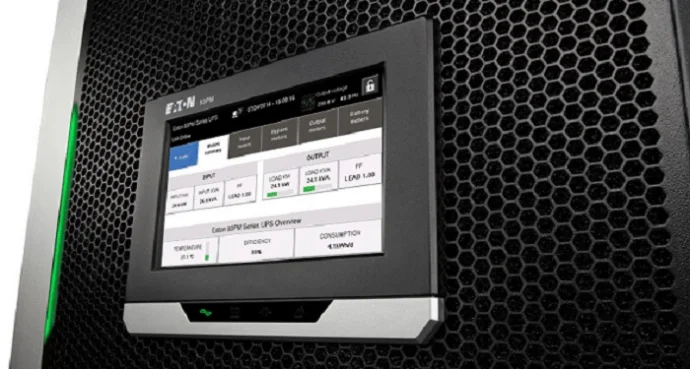Comparing Modular and Monoblock UPS Systems
Most uninterruptible power supplies above 10kVA have the facility for parallel operation. This means that two or more UPS systems can be connected in parallel to provide N+X resilience or increased total capacity.
Monoblock UPS systems are fixed capacity systems. The only way to add additional power to a UPS installation is to add another monoblock UPS and typically this had to be of the same rating. If the existing UPS system was a 250kVA then additional 250kVA UPS would give N+1 redundancy or a 500KVA (2×250kVA capacity system).
Monoblock UPS systems capable of parallel operation would have parallel cards fitted to them with interconnecting cables to provide a closed-loop communications path of Master and Slave units. UPS systems can be powered down and removed from the configuration even if one of them was the Master unit as a Slave would take over this role.
Each monoblock UPS system would have the prerequisite electrical infrastructure and power distribution including static and manual maintenance bypass switches. The UPS could have dual input supplies (A and B feeds) and share a battery or have their own battery set connection. Externally, a wrap-around central bypass arrangement could be installed.
Within this type of parallel UPS installation the individual UPS systems would be referred to as UPS modules even though they are not a true modular design.
Modular UPS Systems
Modular uninterruptible power systems provide the same high-quality output as monoblock UPS systems but use a different architecture. A modular UPS is based around a fixed capacity frame size into which it is to install fixed module ratings.
A typical UPS frame size could be 500kW and the UPS modules could be 50kW. With this modular UPS system, the UPS frame could take from 1 to 10 UPS modules. The modular system allows the UPS to be right-sized for the current load (with or without N+X redundancy). The system capacity can be easily expanded using additional plug-in modules without disruption to the connected loads.
The UPS frame would house the mains power and load connections and bypass arrangements. Some modular UPS frames incorporate both a maintenance and static bypass arrangement. Others feature a maintenance bypass only as each UPS modules incorporates their own static switch for overload and fault conditions.
Modular UPS Advantages
This type of UPS system is becoming more popular within fast growing server room and datacentre environments. The modular approach allows for load right-sizing, lower service and maintenance costs, and higher operating efficiency.
Modular UPS systems typically feature sleep-modes to improve operating efficiency. The architecture commands unused or under-capacity UPS modules to power down to a ‘sleep mode’. In this mode the UPS modules electronics are activated but the modules are not directly powering the load or charging the battery. If the mains power supply fails or the load changes, the UPS modules are brought back into circuit until a new steady state is achieved. The UPS architecture also cycles the modules so that all are used regularly.
Modular Expansion Options
A modular 500kW UPS frame can house up to ten 50kW modules. UPS modules can be installed to power a datacentre and provide N+1 resilience. If the load is 200kW then four modules would cover the load and an additional one unit would provide N+1 redundancy. For higher Tier rated datacentres, the uninterruptible power supply could also be installed with dual input supplies (A and B).
Lower Operating Costs
Whilst modular uninterruptible power supplies can have higher capital costs, their operating costs can be lower thanks to improved energy efficiency and lower maintenance costs.
Whilst the operational energy efficiency may on paper be comparable to a monoblock UPS system at 80-100% load, the modular approach is more adaptable. Modern modular UPS can typically operate over a wide load profile down to 25% at 98% operating efficiency in on-line mode. Unused capacity due to fluctuating server utilisation can lead to UPS modules going into sleep mode to save further power.
Lower Maintenance Contract Prices
Modular UPS can require less on-site time for service and maintenance than monoblock systems. If a module requires replacement this can be accomplished within 30 minutes of the service engineer being on site. As the UPS module is plugged-in, it will go through a power-up routine and self-check. Only if the UPS module tests out 100% will it signal to the UPS frame that it is capable of load support. If spares are needed for a monoblock UPS, the spares could tale some time to arrive from an off-site store if there is no ‘crash kit’ on site.
Plug-in Lead Acid and Lithium-ion UPS Batteries
Plug-in battery packs are becoming popular options for some modular UPS systems for short runtimes. Longer backup times require an external battery installation, and this may use valve regulated lead acid (VRLA) batteries in cabinets or on stands.
Lithium-ion battery options provide further options. Firstly UPS electronics can typically operate at higher ambient temperatures than VRLA batteries which need an ambient temperature of 20-25˚C in order to prevent performance degradation. Using Lithium batteries can lead to lower requirements for cooling and improved energy usage and especially where the datacentre or server room installation wants to run at higher ambient temperatures as suggested by ASHRAE (https://www.ashrae.org).
Lithium batteries have a greater capacity for faster and more frequent charge/discharge cycles than VRLA batteries. Their installation with a modular uninterruptible power supply provides the option to the datacentre operator to run the battery as an energy storage system and to generate revenue from National Grid demand side response programs.
Centralised or Decentralised UPS Installations
Both monoblock and modular UPS systems can be installed as centralised or decentralised configurations. Modular UPS offer the advantage of being able to be moved between the two types of installation as they can be reconfigured. UPS modules can be added or removed to satisfy the load requirements. Both monoblock and modular UPS offer similar levels of reliability. Monoblock UPS have a longer field history but the design power electronics of both are similar.
Whether you are considering a monoblock UPS installation or a modular approach, Server Room Environments works with leading UPS manufacturers and offers a free impartial service including free site surveys across the UK and a complete electrical installation and maintenance service. We have completed installations of both types of system with more than 35 years of experience in this sector.

























